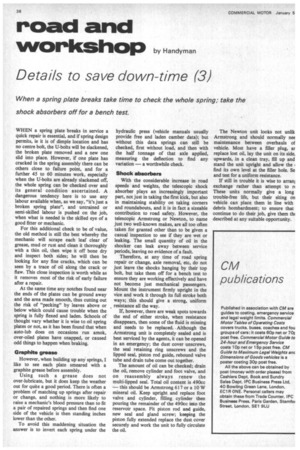road and
Page 40

If you've noticed an error in this article please click here to report it so we can fix it.
workshop by Handyman
Details to save down-time (3)
When a spring plate breaks take time to check the whole spring; take the shock absorbers off for a bench test.
WHEN a spring plate breaks in service a quick repair is essential, and if spring design permits, ie it is of dimple location and has no centre bolt, the U-bolts will be slackened, the broken plate removed and a new one slid into place. However, if one plate has cracked in the spring assembly there can be others close to failure point, and for a further 45 to 60 minutes work, especially when the U-bolts are already slackened off, the whole spring can be checked over and its general condition ascertained. A dangerous tendency here is to use any labour available when, as we say, "it's just a broken spring plate", and untrained or semi-skilled labour is pushed on the job, when what is needed is the skilled eye of a good fitter or mechanic.
For this additional check to be of value, the old method is still the best whereby the mechanic will scrape each leaf clear of grease, mud or rust and clean it thoroughly with a thin oil, then wipe it off bone dry and inspect both sides; he will then be looking for any fine cracks, which can be seen by a trace of oil along the crack or flaw. This close inspection is worth while as it removes most of the risk of early failure after a repair.
At the same time any notches found near the ends of the plates can be ground away and the area made smooth, thus cutting out the risk of "pecking" by leaves above or below which could cause trouble when the spring is fully flexed and laden. Schools of thought vary whether it is wise to oil spring plates or not, as it has been found that when auto-tub does on occasions run amok, over-oiled plates have snapped, or caused odd things to happen when braking.
Graphite grease
However, when building up any springs, I like to see each plate smeared with a graphite grease before assembly.
Using such a grease does not over-lubricate, but it does keep the weather out for quite a good period. There is often a problem of matching up springs after repair or change, and nothing is more likely to raise a mechanic's blood pressure than to fit a pair of repaired springs and then find one side of the vehicle is then standing inches lower than the other.
To avoid this maddening situation the answer is to invert each spring under the hydraulic press (vehicle manuals usually provide free and laden camber data); but without this data springs can still be checked, first without load, and then with the half tonnage of that axle applied, measuring the deflection to find any variation — a worthwhile check.
Shock absorbers
With the considerable increase in road speeds and weights, the telescopic shock absorber plays an increasingly important part, not just in taking the first kick, but also in maintaining stability on taking corners and roundabouts, and it is in fact a sizeable contribution to road safety. However, the telescopic Armstrong or Newton, to name just two well-known makes, are all too often taken for granted other than to be given a casual inspection to see if they are wet or leaking. The small quantity of oil in the shocker can leak away between service periods, leaving no evidence of a fault.
Therefore, at any time of road spring repair or change, axle removal, etc, do not just leave the shocks hanging by their top bolt, but take them off for a bench test to ensure they are working effectively and have not become just mechanical passengers. Mount the instrument firmly upright in the vice and work it through its full stroke both ways; this should give a strong, uniform resistance all the way.
If, however, there are weak spots towards the end of either stroke, when resistance disappears, then some of the fluid is missing and needs to be replaced. Although the Armstrong unit is completely sealed and is best serviced by the agents, it can be opened in an emergency; the dust cover unscrews, the seal retaining ring unscrews and the lipped seal, piston rod guide, rebound valve tube and drain tube come out together.
The amount of oil can be checked; drain the oil, remove cylinder and foot valve, and on reassembly always renew the multi-lipped seal. Total oil content is 490cc — this should be Armstrong 617 or a 10 W mineral oil. Keep upright and replace foot valve and cylinder, filling cylinder then pouring the remainder of the 490cc into the reservoir space. Fit piston rod and guide, new seal and gland screw; keeping the piston fully extended replace the dust cover securely and work the unit to fully circulate the oil. The Newton unit looks not unlik Armstrong and should normally nee maintenance between overhauls of vehicle. Most have a filler plug, ar replace lost oil, lay the unit on its side, upwards, in a clean tray, fill up and stand the unit upright and allow the find its own level at the filler hole. Se and test for a uniform resistance.
If still in trouble it is wise to arrant exchange rather than attempt to r( These units normally give a long trouble-free life, but their siting on vehicle can place them in line with debris bombardment; to ensure that continue to do their job, give them th( described at any suitable opportunity.




























































































